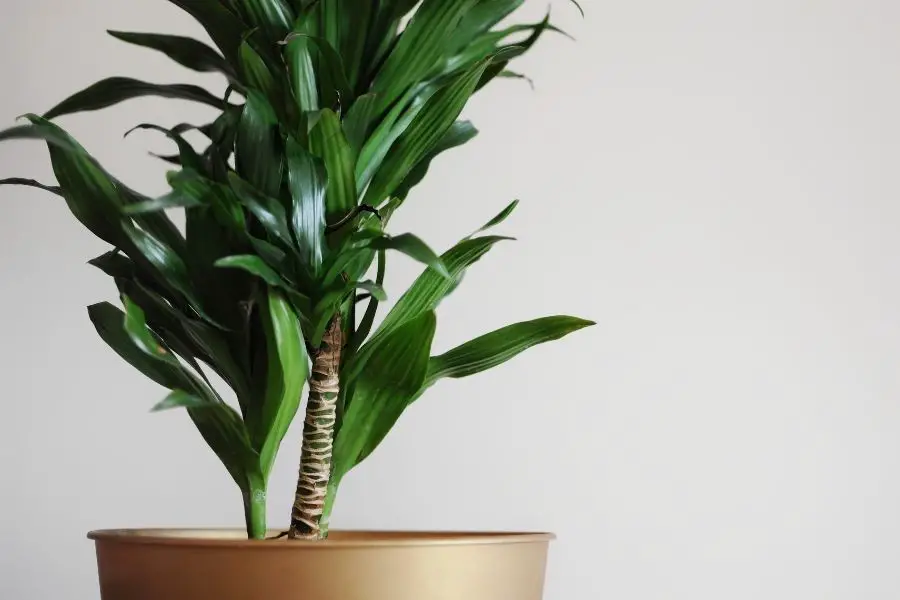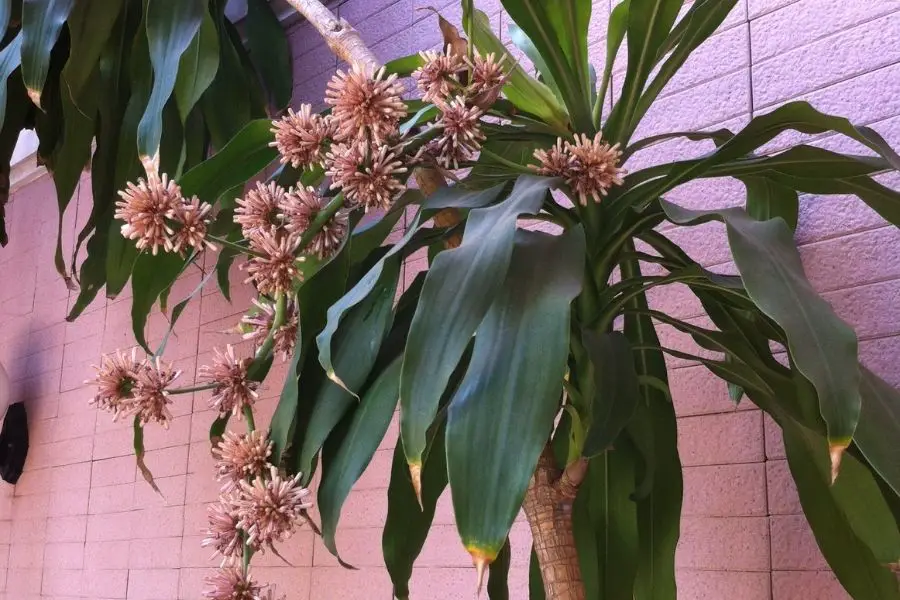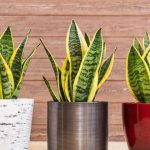
Corn Plant (Dracaena fragrans) is named for its shiny green leaves and woody stalk that mimic the look of an actual corn plant. As it matures, it develops a solid stem, and the leaves concentrate at the top of the stems. It can grow as tall as your ceiling if you let it!
Older plants may even produce a spray of fragrant, white, pink, or purple flowers if the conditions are right (although this is rare when they’re grown as houseplants). In this post, we’ll cover all aspects of corn plant care to keep this lovely foliage plant thriving in your home.
Corn Plant Care
Corn Plant is extremely easy to care for. I would rate it up there with Snake Plant in its ability to tolerate neglect, low light, and even under-watering. With a little care, however, this plant will thrive and produce beautiful foliage (and sometimes flowers) for years.

Due to its growth habit, Corn Plant is often considered an exceptional indoor tree that can grow in low light. It’s also a great houseplant for allergy sufferers due to its effectiveness at removing toxins from the air. Here’s a brief run-down of corn plant’s care requirements:
- TEMPERATURE: 60 – 75 degrees F (16 – 24 degrees C)
- LIGHT: Low to Bright, Indirect
- HUMIDITY: Moderate
- SAFETY: Toxic to cats and dogs when ingested
- DIFFICULTY: Easy
Keep reading for more in-depth care information, including feeding, propagation, potting, maintenance, and troubleshooting.
Water
If you’re the kind of houseplant parent who forgets to water occasionally, Dracaena fragrans will forgive you. Although it prefers the soil to be kept slightly moist (never wet or soggy), it can tolerate under-watering from time to time.
Water when the top 1-inch of soil becomes dry. I insert my finger into the soil up to the first knuckle. If the soil feels dry, it’s time to water. My plant tends to require watering about once a week, but this may vary for you depending on the conditions in your home.
When watering, it’s important to water evenly over the entire surface of the soil to avoid rotting the canes.
Humidity
Corn Plant needs slightly higher humidity levels than the average home provides. Mist your plant at least once a day with a spray bottle of water on the mist setting, or use a handheld mister.
You can also place the plant on a humidity tray (a tray filled with pebbles and water) and/or place it near a high-quality humidifier. See my favorite houseplant humidifier review (the one I’m using right now), or click here to view it directly on Amazon.
Fertilizer
Feed your Corn Plant twice a year – once in early spring and once in summer – using a balanced houseplant fertilizer. My favorite is Jack’s All-Purpose Fertilizer, but any all-purpose food will work.
Read my review of Jack’s Fertilizer to see why I love it so much. I use it on almost all my houseplants except those that require special nutrients – like cacti and succulents.
Corn plant doesn’t need feeding during the colder months. I usually feed mine once in March and again in June.
Light
Although Corn Plant prefers bright, indirect light, it can survive in low light conditions too. It’s one of my favorite houseplants because of this (I live in a darker house).
An east-facing window is the ideal location for this plant, but it can survive almost anywhere as long as it’s not in total darkness. If placed in bright light, it likes a break from the sun in the afternoon. If it gets too much sun, brown spots will start to appear on the leaves.
Keep in mind that variegated cultivars will need more light than non-variegated cultivars.
Temperature
This plant performs best when temperatures remain between 60 – 75 degrees F (16 – 24 degrees C). However, it can survive temperatures as low as 50 degrees F (10 degrees C) for short periods.
Potting
Plant in a commercial potting soil formulated for houseplants. I like this one by Happy Frog because it contains mycorrhizal fungi and beneficial soil microbes, but any high-quality and well-draining potting soil will work fine.
When your Corn Plant outgrows its current pot, replant in a container 2 inches (5 cm) in diameter larger. It’s a slow grower, so avoid re-potting in too large a pot.
Propagation
The easiest way to propagate Corn Plant is to take a cutting from the cane. I would do this when you’re pruning the plant down to a smaller size anyway. Allow the cane to dry, then plant it in moist potting soil. Make sure the bottom or cut part of the cane is touching the soil and roots should form.
Maintenance
If your Corn Plant starts to grow too tall for your liking, just lop off the top six inches or so. The plant will keep on growing, unbothered by the pruning.
Over time, the woody stalks can become top heavy and cause the plant to fall over. You may need to stake very tall plants to prevent this.
Troubleshooting
Here are some common problems indoor gardeners encounter with Corn Plant and suggestions for how to fix them:
- Brown Leaf Tips – If the leaf tips are turning brown, this typically means the plant is getting too much sunlight. Place in a location that receives no more than bright, indirect light, and give the plant a break from the sun in the afternoon if necessary. Avoid direct sunlight.
- Brown Patches on Leaves – This is usually caused by temperatures that drop too low for too long. Make sure you’re keeping the temperature above 54 degrees F (12 degrees C) at night, and preferably above 65 degrees F (16 degrees C).
Where to Buy Corn Plant
This is one plant that I’ve had difficulty finding in local nurseries and stores with garden centers. If you really like this plant but can’t find it locally, I always recommend looking for your houseplants on Etsy.
I love buying from Etsy because the sellers are individuals who really care about the quality of their plants and their reputation. I’ve had great luck getting exotic or hard-to-find plants from sellers on the site.
Click here to see the current listings for corn plant on Etsy.
Additionally, you can always check Amazon for hard-to-find plants. Many of the larger nurseries sell through the site. Click here to see the current Amazon listings for corn plant.




